Virtuous Leadership: A Detailed Literature Review Analysis
VerifiedAdded on 2022/12/14
|9
|2596
|59
Literature Review
AI Summary
This literature review delves into the concept of virtuous leadership, tracing its roots in Aristotelian and Platonic philosophies, and examining its contemporary relevance. The review defines virtuous leadership as a style characterized by ethical conduct, moral decision-making, and a focus on the well-being of the organization and its members. It explores the key assumptions underlying virtuous leadership, including amplification, eudemonics, and inherent value. The analysis contrasts virtuous leadership with other leadership styles, such as ethical and responsible leadership, while highlighting the significance of virtues like courage, justice, prudence, temperance, truthfulness, and humanity. The review synthesizes diverse perspectives on virtuous leadership, its practical implications, and its impact on organizational behavior and performance, emphasizing the importance of ethical practices in modern leadership.
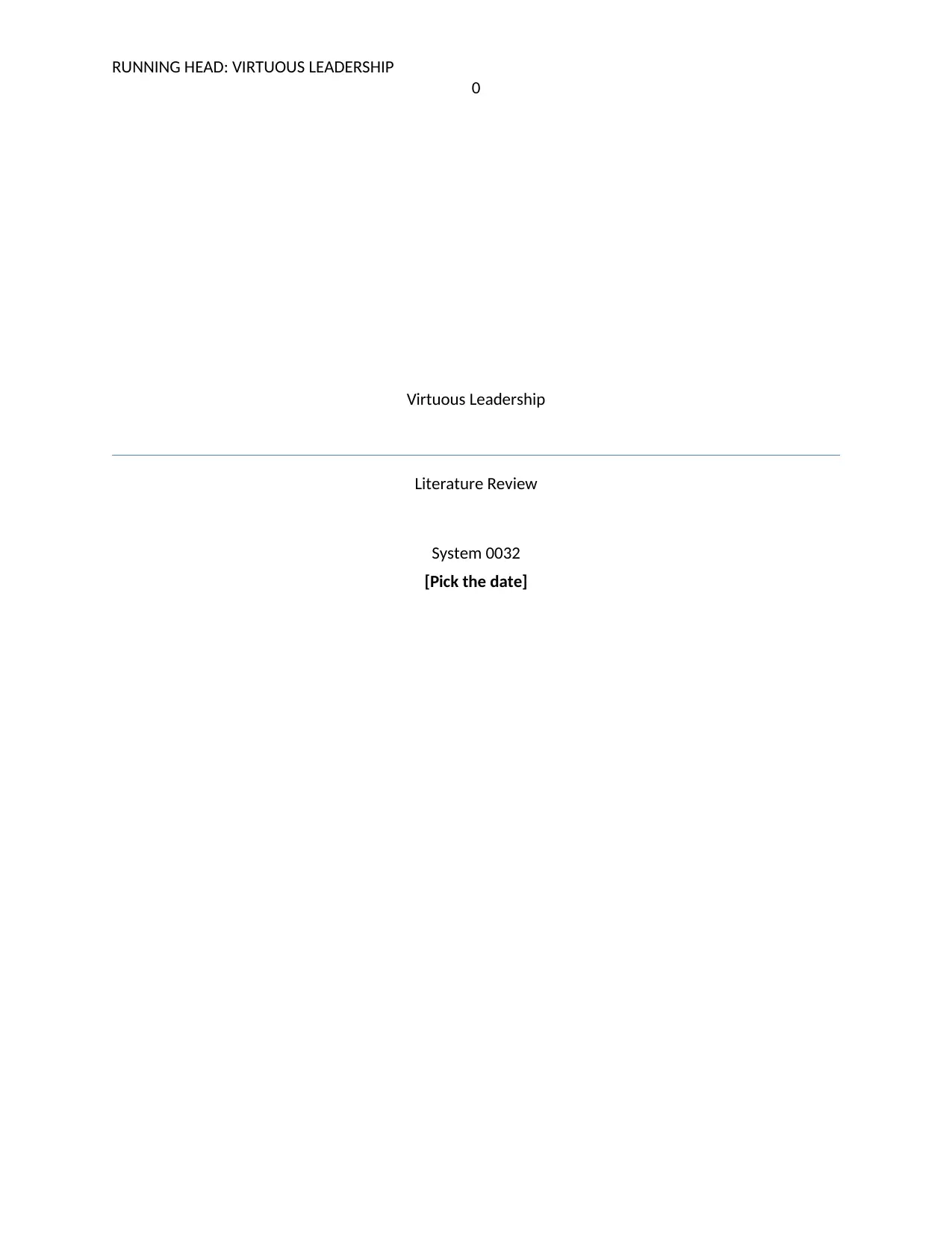
RUNNING HEAD: VIRTUOUS LEADERSHIP
0
Virtuous Leadership
Literature Review
System 0032
[Pick the date]
0
Virtuous Leadership
Literature Review
System 0032
[Pick the date]
Paraphrase This Document
Need a fresh take? Get an instant paraphrase of this document with our AI Paraphraser

Virtuous Leadership
1
Introduction
Virtuous leadership is derived from the Latin word “virtus” means “excellence”. The
concept of virtuousness is based on moral character (Harvard, 2014, p. 83).Cameron and Winn
(Cameron K. S., 2013, p. 110)said that in this competitive business environment, virtuousness is
a rare concept in an organization due to competition amongst the firms for customers and profit.
Furthermore, Cameron added that virtuousness holds a positive preference and focuses on
enriching, elevating and flourishing outcomes.
Leadership is influencing or inducing behavior, attitude and abilities of people in order to
achieve common goals (Northouse, 2010, p. 76). Nowadays this concept gain broader sense with
the implementation of virtues and ethics in the core of business activities that demands the leader
to be ethical. Ethics and values and differentiating what is right and wrong are the essence of
virtuous leadership (Neubert, Carlson, Kacmar, Roberts, & Chonko, 2009, p. 160). Different
authors provide different opinions on the concept of virtues and ethics and thinks that it is
controversial to consider it as an important aspect in the business (Jose, Ferrero, & Guitian,
2018, p. 205).
Virtuous Leadership is defined as differentiation between right and wrong by a leader,
taking necessary actions to ensure integrity and justice, and inducing or directing others to attain
right and moral objectives for their organization and in their life. The main aim under this
leadership style is to help others to connect to a purposeful life (Bell, Dyck, & Neubert, 2017, p.
113). According to Aristotle a leader needs practical wisdom, and he defined practical wisdom as
the need to understand how things are and how it can be better other than they are. It is all about
changing the condition of the society and organization for a better world through identifying
1
Introduction
Virtuous leadership is derived from the Latin word “virtus” means “excellence”. The
concept of virtuousness is based on moral character (Harvard, 2014, p. 83).Cameron and Winn
(Cameron K. S., 2013, p. 110)said that in this competitive business environment, virtuousness is
a rare concept in an organization due to competition amongst the firms for customers and profit.
Furthermore, Cameron added that virtuousness holds a positive preference and focuses on
enriching, elevating and flourishing outcomes.
Leadership is influencing or inducing behavior, attitude and abilities of people in order to
achieve common goals (Northouse, 2010, p. 76). Nowadays this concept gain broader sense with
the implementation of virtues and ethics in the core of business activities that demands the leader
to be ethical. Ethics and values and differentiating what is right and wrong are the essence of
virtuous leadership (Neubert, Carlson, Kacmar, Roberts, & Chonko, 2009, p. 160). Different
authors provide different opinions on the concept of virtues and ethics and thinks that it is
controversial to consider it as an important aspect in the business (Jose, Ferrero, & Guitian,
2018, p. 205).
Virtuous Leadership is defined as differentiation between right and wrong by a leader,
taking necessary actions to ensure integrity and justice, and inducing or directing others to attain
right and moral objectives for their organization and in their life. The main aim under this
leadership style is to help others to connect to a purposeful life (Bell, Dyck, & Neubert, 2017, p.
113). According to Aristotle a leader needs practical wisdom, and he defined practical wisdom as
the need to understand how things are and how it can be better other than they are. It is all about
changing the condition of the society and organization for a better world through identifying
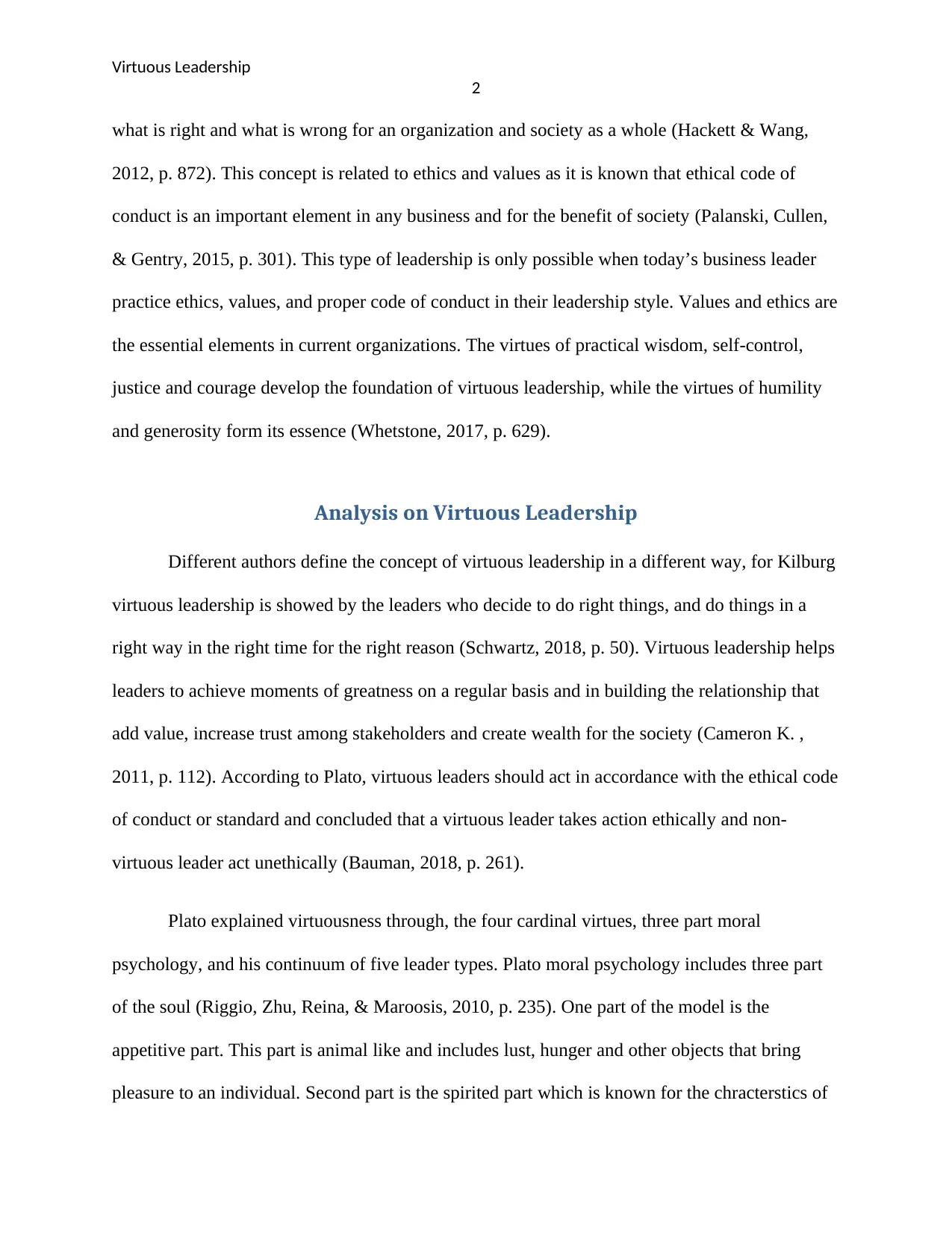
Virtuous Leadership
2
what is right and what is wrong for an organization and society as a whole (Hackett & Wang,
2012, p. 872). This concept is related to ethics and values as it is known that ethical code of
conduct is an important element in any business and for the benefit of society (Palanski, Cullen,
& Gentry, 2015, p. 301). This type of leadership is only possible when today’s business leader
practice ethics, values, and proper code of conduct in their leadership style. Values and ethics are
the essential elements in current organizations. The virtues of practical wisdom, self-control,
justice and courage develop the foundation of virtuous leadership, while the virtues of humility
and generosity form its essence (Whetstone, 2017, p. 629).
Analysis on Virtuous Leadership
Different authors define the concept of virtuous leadership in a different way, for Kilburg
virtuous leadership is showed by the leaders who decide to do right things, and do things in a
right way in the right time for the right reason (Schwartz, 2018, p. 50). Virtuous leadership helps
leaders to achieve moments of greatness on a regular basis and in building the relationship that
add value, increase trust among stakeholders and create wealth for the society (Cameron K. ,
2011, p. 112). According to Plato, virtuous leaders should act in accordance with the ethical code
of conduct or standard and concluded that a virtuous leader takes action ethically and non-
virtuous leader act unethically (Bauman, 2018, p. 261).
Plato explained virtuousness through, the four cardinal virtues, three part moral
psychology, and his continuum of five leader types. Plato moral psychology includes three part
of the soul (Riggio, Zhu, Reina, & Maroosis, 2010, p. 235). One part of the model is the
appetitive part. This part is animal like and includes lust, hunger and other objects that bring
pleasure to an individual. Second part is the spirited part which is known for the chracterstics of
2
what is right and what is wrong for an organization and society as a whole (Hackett & Wang,
2012, p. 872). This concept is related to ethics and values as it is known that ethical code of
conduct is an important element in any business and for the benefit of society (Palanski, Cullen,
& Gentry, 2015, p. 301). This type of leadership is only possible when today’s business leader
practice ethics, values, and proper code of conduct in their leadership style. Values and ethics are
the essential elements in current organizations. The virtues of practical wisdom, self-control,
justice and courage develop the foundation of virtuous leadership, while the virtues of humility
and generosity form its essence (Whetstone, 2017, p. 629).
Analysis on Virtuous Leadership
Different authors define the concept of virtuous leadership in a different way, for Kilburg
virtuous leadership is showed by the leaders who decide to do right things, and do things in a
right way in the right time for the right reason (Schwartz, 2018, p. 50). Virtuous leadership helps
leaders to achieve moments of greatness on a regular basis and in building the relationship that
add value, increase trust among stakeholders and create wealth for the society (Cameron K. ,
2011, p. 112). According to Plato, virtuous leaders should act in accordance with the ethical code
of conduct or standard and concluded that a virtuous leader takes action ethically and non-
virtuous leader act unethically (Bauman, 2018, p. 261).
Plato explained virtuousness through, the four cardinal virtues, three part moral
psychology, and his continuum of five leader types. Plato moral psychology includes three part
of the soul (Riggio, Zhu, Reina, & Maroosis, 2010, p. 235). One part of the model is the
appetitive part. This part is animal like and includes lust, hunger and other objects that bring
pleasure to an individual. Second part is the spirited part which is known for the chracterstics of
⊘ This is a preview!⊘
Do you want full access?
Subscribe today to unlock all pages.

Trusted by 1+ million students worldwide
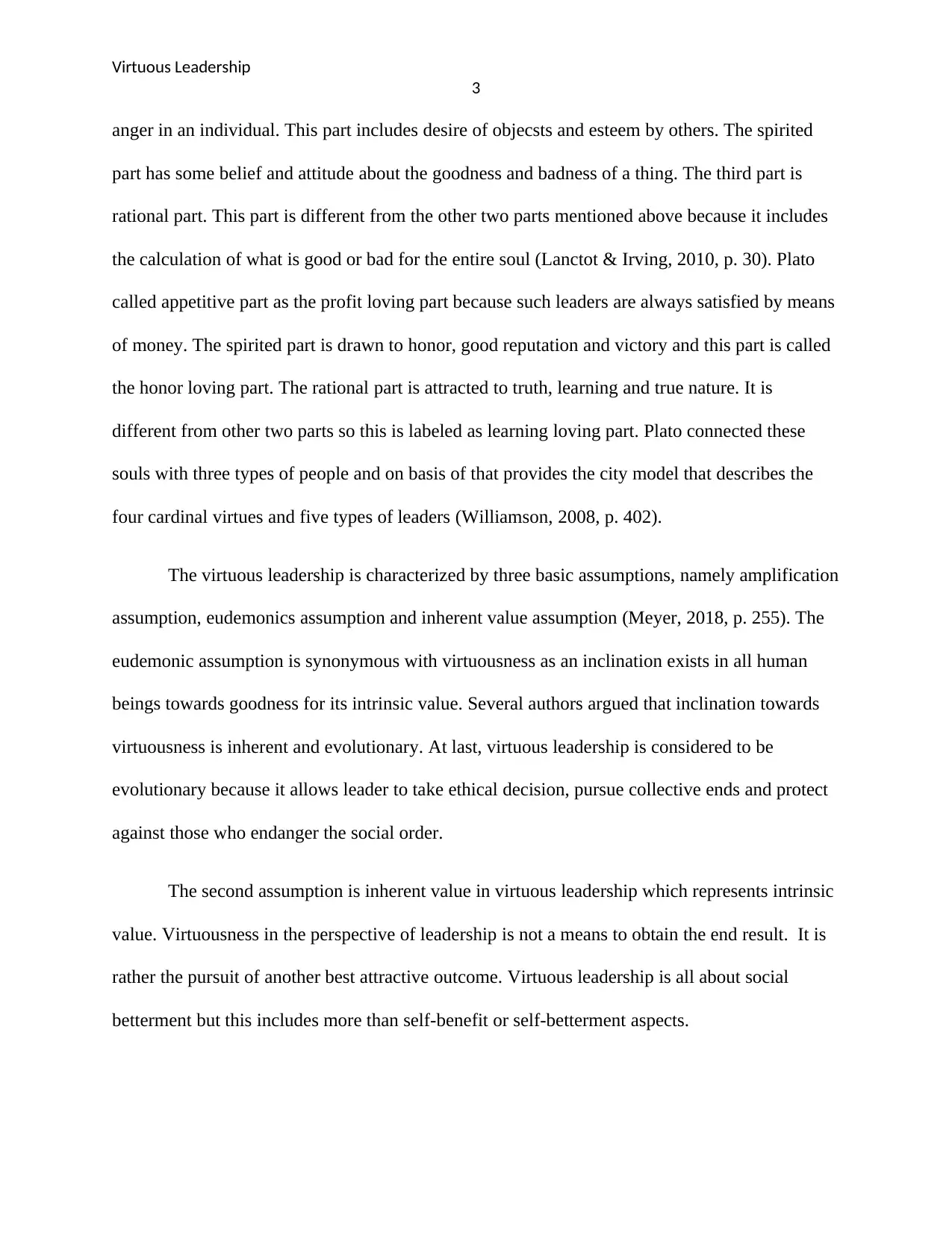
Virtuous Leadership
3
anger in an individual. This part includes desire of objecsts and esteem by others. The spirited
part has some belief and attitude about the goodness and badness of a thing. The third part is
rational part. This part is different from the other two parts mentioned above because it includes
the calculation of what is good or bad for the entire soul (Lanctot & Irving, 2010, p. 30). Plato
called appetitive part as the profit loving part because such leaders are always satisfied by means
of money. The spirited part is drawn to honor, good reputation and victory and this part is called
the honor loving part. The rational part is attracted to truth, learning and true nature. It is
different from other two parts so this is labeled as learning loving part. Plato connected these
souls with three types of people and on basis of that provides the city model that describes the
four cardinal virtues and five types of leaders (Williamson, 2008, p. 402).
The virtuous leadership is characterized by three basic assumptions, namely amplification
assumption, eudemonics assumption and inherent value assumption (Meyer, 2018, p. 255). The
eudemonic assumption is synonymous with virtuousness as an inclination exists in all human
beings towards goodness for its intrinsic value. Several authors argued that inclination towards
virtuousness is inherent and evolutionary. At last, virtuous leadership is considered to be
evolutionary because it allows leader to take ethical decision, pursue collective ends and protect
against those who endanger the social order.
The second assumption is inherent value in virtuous leadership which represents intrinsic
value. Virtuousness in the perspective of leadership is not a means to obtain the end result. It is
rather the pursuit of another best attractive outcome. Virtuous leadership is all about social
betterment but this includes more than self-benefit or self-betterment aspects.
3
anger in an individual. This part includes desire of objecsts and esteem by others. The spirited
part has some belief and attitude about the goodness and badness of a thing. The third part is
rational part. This part is different from the other two parts mentioned above because it includes
the calculation of what is good or bad for the entire soul (Lanctot & Irving, 2010, p. 30). Plato
called appetitive part as the profit loving part because such leaders are always satisfied by means
of money. The spirited part is drawn to honor, good reputation and victory and this part is called
the honor loving part. The rational part is attracted to truth, learning and true nature. It is
different from other two parts so this is labeled as learning loving part. Plato connected these
souls with three types of people and on basis of that provides the city model that describes the
four cardinal virtues and five types of leaders (Williamson, 2008, p. 402).
The virtuous leadership is characterized by three basic assumptions, namely amplification
assumption, eudemonics assumption and inherent value assumption (Meyer, 2018, p. 255). The
eudemonic assumption is synonymous with virtuousness as an inclination exists in all human
beings towards goodness for its intrinsic value. Several authors argued that inclination towards
virtuousness is inherent and evolutionary. At last, virtuous leadership is considered to be
evolutionary because it allows leader to take ethical decision, pursue collective ends and protect
against those who endanger the social order.
The second assumption is inherent value in virtuous leadership which represents intrinsic
value. Virtuousness in the perspective of leadership is not a means to obtain the end result. It is
rather the pursuit of another best attractive outcome. Virtuous leadership is all about social
betterment but this includes more than self-benefit or self-betterment aspects.
Paraphrase This Document
Need a fresh take? Get an instant paraphrase of this document with our AI Paraphraser
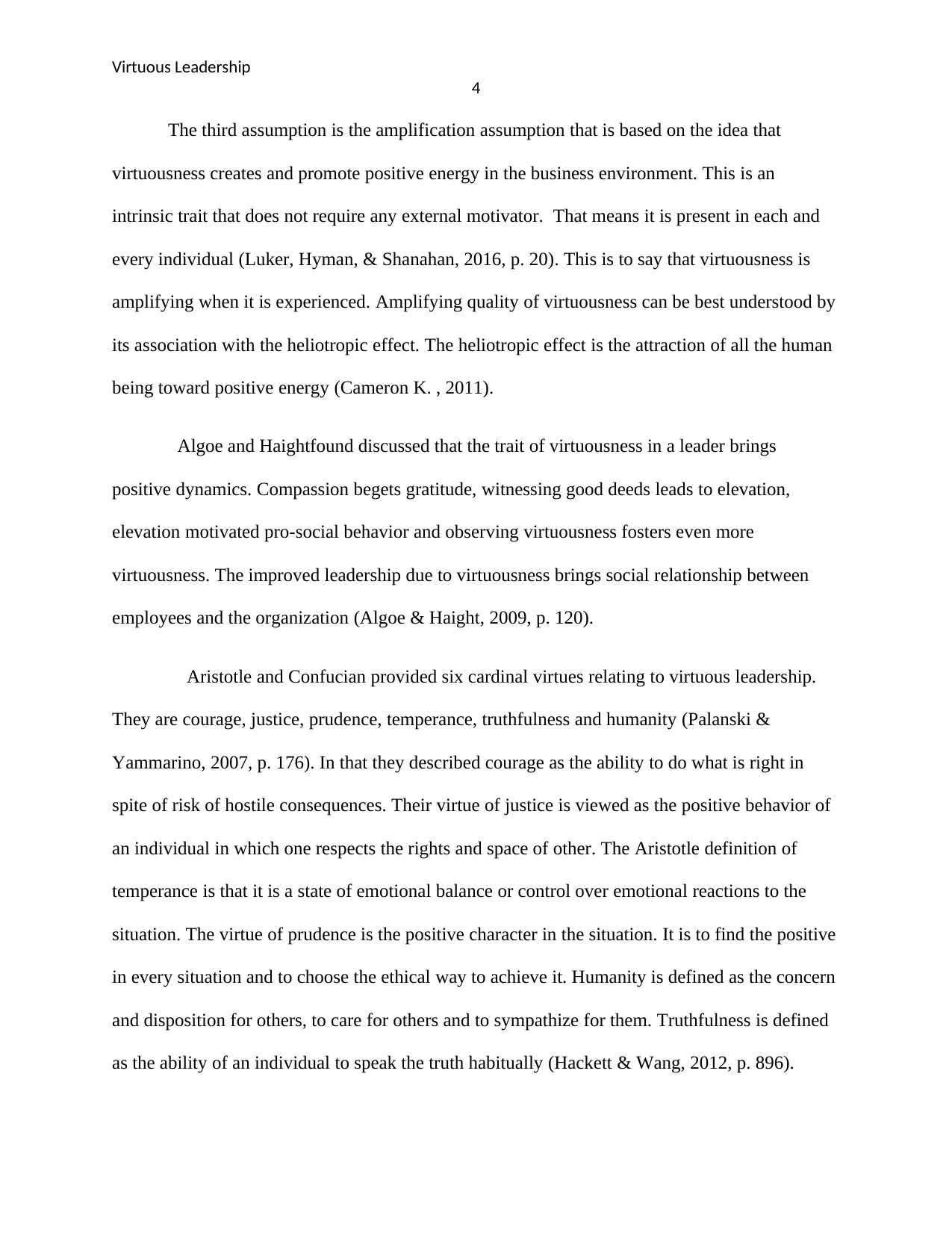
Virtuous Leadership
4
The third assumption is the amplification assumption that is based on the idea that
virtuousness creates and promote positive energy in the business environment. This is an
intrinsic trait that does not require any external motivator. That means it is present in each and
every individual (Luker, Hyman, & Shanahan, 2016, p. 20). This is to say that virtuousness is
amplifying when it is experienced. Amplifying quality of virtuousness can be best understood by
its association with the heliotropic effect. The heliotropic effect is the attraction of all the human
being toward positive energy (Cameron K. , 2011).
Algoe and Haightfound discussed that the trait of virtuousness in a leader brings
positive dynamics. Compassion begets gratitude, witnessing good deeds leads to elevation,
elevation motivated pro-social behavior and observing virtuousness fosters even more
virtuousness. The improved leadership due to virtuousness brings social relationship between
employees and the organization (Algoe & Haight, 2009, p. 120).
Aristotle and Confucian provided six cardinal virtues relating to virtuous leadership.
They are courage, justice, prudence, temperance, truthfulness and humanity (Palanski &
Yammarino, 2007, p. 176). In that they described courage as the ability to do what is right in
spite of risk of hostile consequences. Their virtue of justice is viewed as the positive behavior of
an individual in which one respects the rights and space of other. The Aristotle definition of
temperance is that it is a state of emotional balance or control over emotional reactions to the
situation. The virtue of prudence is the positive character in the situation. It is to find the positive
in every situation and to choose the ethical way to achieve it. Humanity is defined as the concern
and disposition for others, to care for others and to sympathize for them. Truthfulness is defined
as the ability of an individual to speak the truth habitually (Hackett & Wang, 2012, p. 896).
4
The third assumption is the amplification assumption that is based on the idea that
virtuousness creates and promote positive energy in the business environment. This is an
intrinsic trait that does not require any external motivator. That means it is present in each and
every individual (Luker, Hyman, & Shanahan, 2016, p. 20). This is to say that virtuousness is
amplifying when it is experienced. Amplifying quality of virtuousness can be best understood by
its association with the heliotropic effect. The heliotropic effect is the attraction of all the human
being toward positive energy (Cameron K. , 2011).
Algoe and Haightfound discussed that the trait of virtuousness in a leader brings
positive dynamics. Compassion begets gratitude, witnessing good deeds leads to elevation,
elevation motivated pro-social behavior and observing virtuousness fosters even more
virtuousness. The improved leadership due to virtuousness brings social relationship between
employees and the organization (Algoe & Haight, 2009, p. 120).
Aristotle and Confucian provided six cardinal virtues relating to virtuous leadership.
They are courage, justice, prudence, temperance, truthfulness and humanity (Palanski &
Yammarino, 2007, p. 176). In that they described courage as the ability to do what is right in
spite of risk of hostile consequences. Their virtue of justice is viewed as the positive behavior of
an individual in which one respects the rights and space of other. The Aristotle definition of
temperance is that it is a state of emotional balance or control over emotional reactions to the
situation. The virtue of prudence is the positive character in the situation. It is to find the positive
in every situation and to choose the ethical way to achieve it. Humanity is defined as the concern
and disposition for others, to care for others and to sympathize for them. Truthfulness is defined
as the ability of an individual to speak the truth habitually (Hackett & Wang, 2012, p. 896).
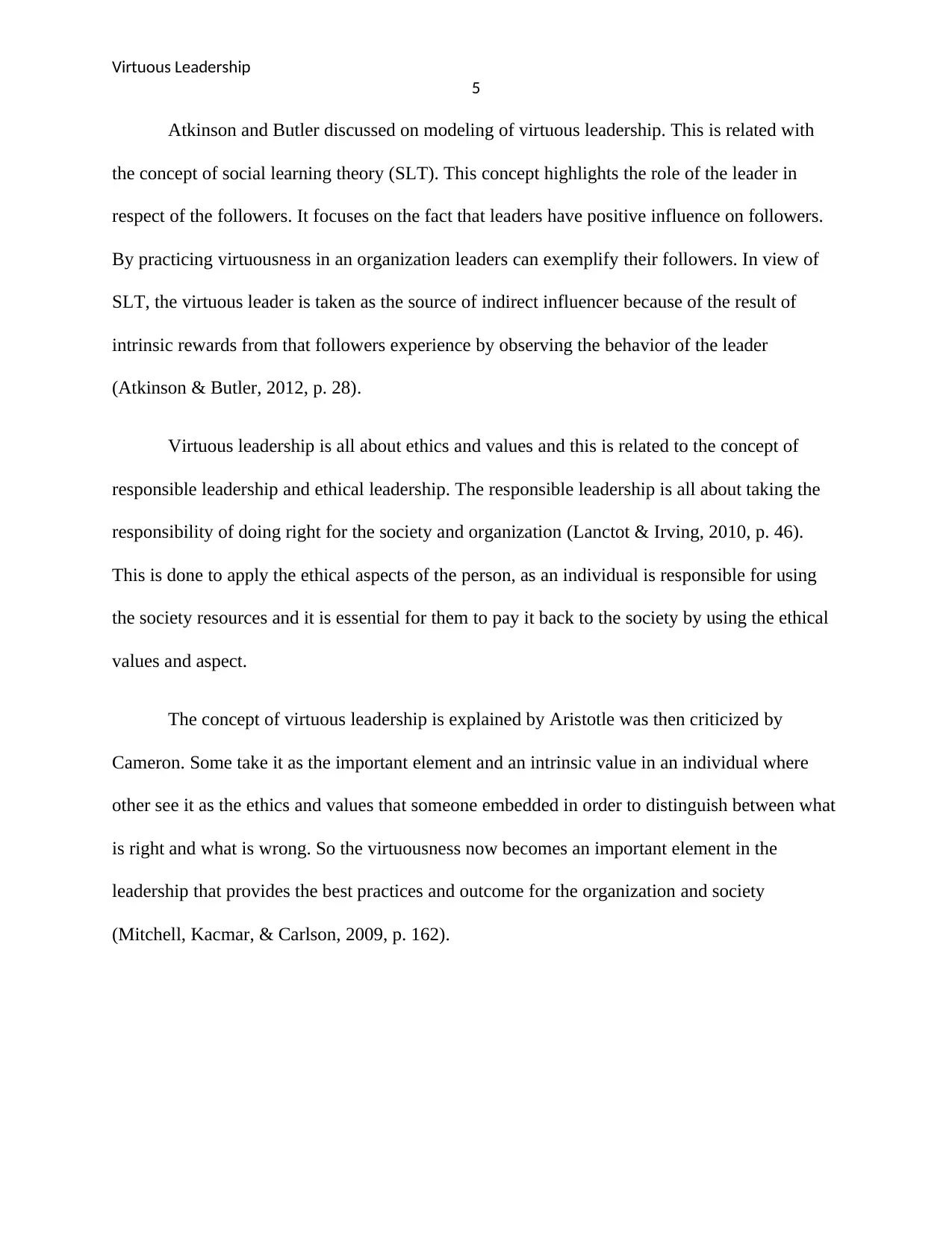
Virtuous Leadership
5
Atkinson and Butler discussed on modeling of virtuous leadership. This is related with
the concept of social learning theory (SLT). This concept highlights the role of the leader in
respect of the followers. It focuses on the fact that leaders have positive influence on followers.
By practicing virtuousness in an organization leaders can exemplify their followers. In view of
SLT, the virtuous leader is taken as the source of indirect influencer because of the result of
intrinsic rewards from that followers experience by observing the behavior of the leader
(Atkinson & Butler, 2012, p. 28).
Virtuous leadership is all about ethics and values and this is related to the concept of
responsible leadership and ethical leadership. The responsible leadership is all about taking the
responsibility of doing right for the society and organization (Lanctot & Irving, 2010, p. 46).
This is done to apply the ethical aspects of the person, as an individual is responsible for using
the society resources and it is essential for them to pay it back to the society by using the ethical
values and aspect.
The concept of virtuous leadership is explained by Aristotle was then criticized by
Cameron. Some take it as the important element and an intrinsic value in an individual where
other see it as the ethics and values that someone embedded in order to distinguish between what
is right and what is wrong. So the virtuousness now becomes an important element in the
leadership that provides the best practices and outcome for the organization and society
(Mitchell, Kacmar, & Carlson, 2009, p. 162).
5
Atkinson and Butler discussed on modeling of virtuous leadership. This is related with
the concept of social learning theory (SLT). This concept highlights the role of the leader in
respect of the followers. It focuses on the fact that leaders have positive influence on followers.
By practicing virtuousness in an organization leaders can exemplify their followers. In view of
SLT, the virtuous leader is taken as the source of indirect influencer because of the result of
intrinsic rewards from that followers experience by observing the behavior of the leader
(Atkinson & Butler, 2012, p. 28).
Virtuous leadership is all about ethics and values and this is related to the concept of
responsible leadership and ethical leadership. The responsible leadership is all about taking the
responsibility of doing right for the society and organization (Lanctot & Irving, 2010, p. 46).
This is done to apply the ethical aspects of the person, as an individual is responsible for using
the society resources and it is essential for them to pay it back to the society by using the ethical
values and aspect.
The concept of virtuous leadership is explained by Aristotle was then criticized by
Cameron. Some take it as the important element and an intrinsic value in an individual where
other see it as the ethics and values that someone embedded in order to distinguish between what
is right and what is wrong. So the virtuousness now becomes an important element in the
leadership that provides the best practices and outcome for the organization and society
(Mitchell, Kacmar, & Carlson, 2009, p. 162).
⊘ This is a preview!⊘
Do you want full access?
Subscribe today to unlock all pages.

Trusted by 1+ million students worldwide
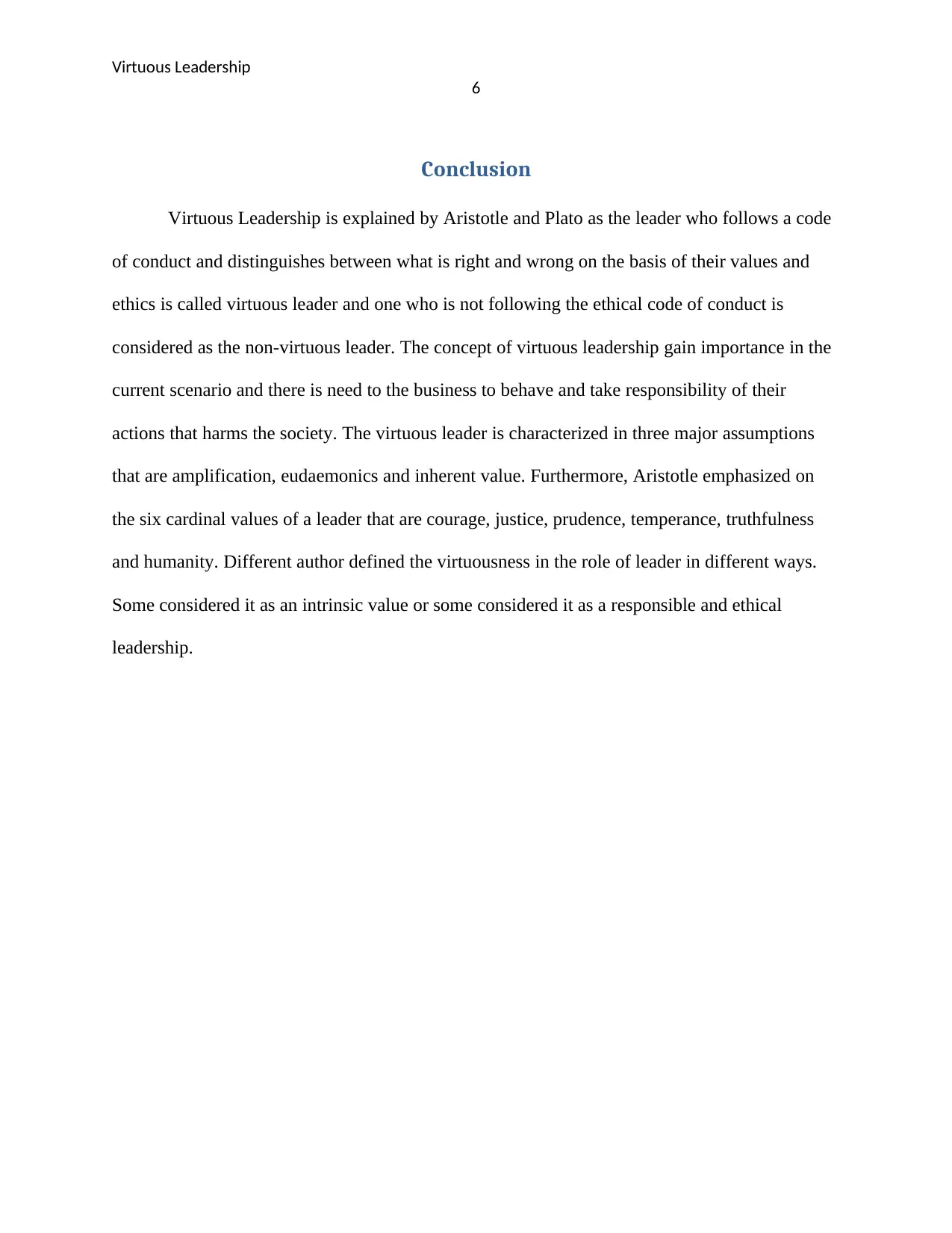
Virtuous Leadership
6
Conclusion
Virtuous Leadership is explained by Aristotle and Plato as the leader who follows a code
of conduct and distinguishes between what is right and wrong on the basis of their values and
ethics is called virtuous leader and one who is not following the ethical code of conduct is
considered as the non-virtuous leader. The concept of virtuous leadership gain importance in the
current scenario and there is need to the business to behave and take responsibility of their
actions that harms the society. The virtuous leader is characterized in three major assumptions
that are amplification, eudaemonics and inherent value. Furthermore, Aristotle emphasized on
the six cardinal values of a leader that are courage, justice, prudence, temperance, truthfulness
and humanity. Different author defined the virtuousness in the role of leader in different ways.
Some considered it as an intrinsic value or some considered it as a responsible and ethical
leadership.
6
Conclusion
Virtuous Leadership is explained by Aristotle and Plato as the leader who follows a code
of conduct and distinguishes between what is right and wrong on the basis of their values and
ethics is called virtuous leader and one who is not following the ethical code of conduct is
considered as the non-virtuous leader. The concept of virtuous leadership gain importance in the
current scenario and there is need to the business to behave and take responsibility of their
actions that harms the society. The virtuous leader is characterized in three major assumptions
that are amplification, eudaemonics and inherent value. Furthermore, Aristotle emphasized on
the six cardinal values of a leader that are courage, justice, prudence, temperance, truthfulness
and humanity. Different author defined the virtuousness in the role of leader in different ways.
Some considered it as an intrinsic value or some considered it as a responsible and ethical
leadership.
Paraphrase This Document
Need a fresh take? Get an instant paraphrase of this document with our AI Paraphraser

Virtuous Leadership
7
References
Algoe, S. B., & Haight, J. (2009). Witnessing excellence in action: The others praising emotions of
elevation, gratitude and admiration. Journal of Positive Psychology, 105-127.
Atkinson, T. N., & Butler, J. W. (2012). From Regulation to Virtue: A Critique of Ethical Formalism in
Research Organization. Journal of Administration, 17-32.
Bauman, D. C. (2018). Plato on virtuous leadership: An ancient model for modern business . Business
Ethics Quarterly, 251-274.
Bell, G. G., Dyck, B., & Neubert, J. M. (2017). Ethical leadership, Virtue theory and generic strategies.
Radical thoughts on ethical leadership, 113.
Cameron, K. (2011). Responsible Leadership as Virtuous leadership. Journal of Business Ethics, 25-35.
Cameron, K. S. (2013). Practicing Positive leadership. San Francisco: BK Business Book.
Hackett, R. D., & Wang, G. (2012). Virtues and Leadership: An integrating conceptual framework
founded in Aristotelian and Confucian perspectives on virtues. Management Decision , 868-899.
Harvard, A. (2014). Virtuous Leadership: An agenda of Persoanl Excellence. US: Scepter Publishers.
Jose, A., Ferrero, I., & Guitian, G. (2018). Business Ethics: A virtue ethics and common good approach.
New York: Routledge.
Lanctot, J. D., & Irving, J. A. (2010). Character and Leadership: Situating servant leadership in a proposed
virtue framework. International Journal of Leadership Studies, 28-50.
Lanctot, J. D., & Irving, J. A. (2010). Character and leadership: Situating servant leadership in a proposed
virtues framework. International journal of leadership studies, 28-50.
Luker, G. C., Hyman, M. R., & Shanahan, K. J. (2016). Measuring Systems of Virtues Development. .
Handbook of Virtue Ethics in Business and Management, 1-25.
Meyer, M. (2018). The evolution and challenges of the concept of organizational virtuousness in positive
organizational scholarship. Journal of Business Ethics, 245-264.
Mitchell, J., Kacmar, K. M., & Carlson, D. S. (2009). The virtuous influence of ethical leadership behavior:
Evidence from the field. Journal of Business Ethics, 157-170.
Neubert, M. J., Carlson, D. S., Kacmar, K. M., Roberts, J. A., & Chonko, L. B. (2009). The virtuous influence
of ethical leadership behavior. Journal of Business Ethics, 157-180.
7
References
Algoe, S. B., & Haight, J. (2009). Witnessing excellence in action: The others praising emotions of
elevation, gratitude and admiration. Journal of Positive Psychology, 105-127.
Atkinson, T. N., & Butler, J. W. (2012). From Regulation to Virtue: A Critique of Ethical Formalism in
Research Organization. Journal of Administration, 17-32.
Bauman, D. C. (2018). Plato on virtuous leadership: An ancient model for modern business . Business
Ethics Quarterly, 251-274.
Bell, G. G., Dyck, B., & Neubert, J. M. (2017). Ethical leadership, Virtue theory and generic strategies.
Radical thoughts on ethical leadership, 113.
Cameron, K. (2011). Responsible Leadership as Virtuous leadership. Journal of Business Ethics, 25-35.
Cameron, K. S. (2013). Practicing Positive leadership. San Francisco: BK Business Book.
Hackett, R. D., & Wang, G. (2012). Virtues and Leadership: An integrating conceptual framework
founded in Aristotelian and Confucian perspectives on virtues. Management Decision , 868-899.
Harvard, A. (2014). Virtuous Leadership: An agenda of Persoanl Excellence. US: Scepter Publishers.
Jose, A., Ferrero, I., & Guitian, G. (2018). Business Ethics: A virtue ethics and common good approach.
New York: Routledge.
Lanctot, J. D., & Irving, J. A. (2010). Character and Leadership: Situating servant leadership in a proposed
virtue framework. International Journal of Leadership Studies, 28-50.
Lanctot, J. D., & Irving, J. A. (2010). Character and leadership: Situating servant leadership in a proposed
virtues framework. International journal of leadership studies, 28-50.
Luker, G. C., Hyman, M. R., & Shanahan, K. J. (2016). Measuring Systems of Virtues Development. .
Handbook of Virtue Ethics in Business and Management, 1-25.
Meyer, M. (2018). The evolution and challenges of the concept of organizational virtuousness in positive
organizational scholarship. Journal of Business Ethics, 245-264.
Mitchell, J., Kacmar, K. M., & Carlson, D. S. (2009). The virtuous influence of ethical leadership behavior:
Evidence from the field. Journal of Business Ethics, 157-170.
Neubert, M. J., Carlson, D. S., Kacmar, K. M., Roberts, J. A., & Chonko, L. B. (2009). The virtuous influence
of ethical leadership behavior. Journal of Business Ethics, 157-180.
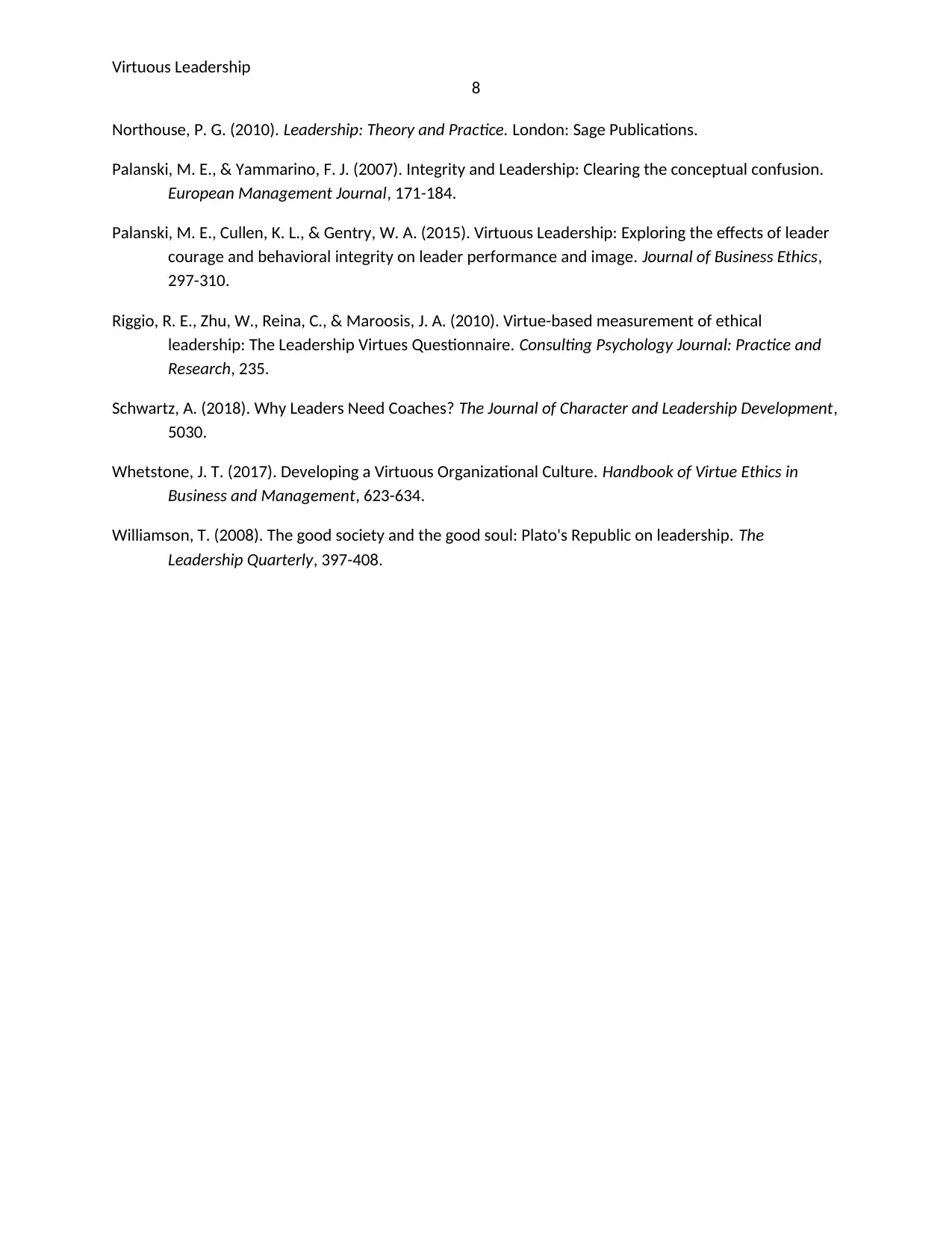
Virtuous Leadership
8
Northouse, P. G. (2010). Leadership: Theory and Practice. London: Sage Publications.
Palanski, M. E., & Yammarino, F. J. (2007). Integrity and Leadership: Clearing the conceptual confusion.
European Management Journal, 171-184.
Palanski, M. E., Cullen, K. L., & Gentry, W. A. (2015). Virtuous Leadership: Exploring the effects of leader
courage and behavioral integrity on leader performance and image. Journal of Business Ethics,
297-310.
Riggio, R. E., Zhu, W., Reina, C., & Maroosis, J. A. (2010). Virtue-based measurement of ethical
leadership: The Leadership Virtues Questionnaire. Consulting Psychology Journal: Practice and
Research, 235.
Schwartz, A. (2018). Why Leaders Need Coaches? The Journal of Character and Leadership Development,
5030.
Whetstone, J. T. (2017). Developing a Virtuous Organizational Culture. Handbook of Virtue Ethics in
Business and Management, 623-634.
Williamson, T. (2008). The good society and the good soul: Plato's Republic on leadership. The
Leadership Quarterly, 397-408.
8
Northouse, P. G. (2010). Leadership: Theory and Practice. London: Sage Publications.
Palanski, M. E., & Yammarino, F. J. (2007). Integrity and Leadership: Clearing the conceptual confusion.
European Management Journal, 171-184.
Palanski, M. E., Cullen, K. L., & Gentry, W. A. (2015). Virtuous Leadership: Exploring the effects of leader
courage and behavioral integrity on leader performance and image. Journal of Business Ethics,
297-310.
Riggio, R. E., Zhu, W., Reina, C., & Maroosis, J. A. (2010). Virtue-based measurement of ethical
leadership: The Leadership Virtues Questionnaire. Consulting Psychology Journal: Practice and
Research, 235.
Schwartz, A. (2018). Why Leaders Need Coaches? The Journal of Character and Leadership Development,
5030.
Whetstone, J. T. (2017). Developing a Virtuous Organizational Culture. Handbook of Virtue Ethics in
Business and Management, 623-634.
Williamson, T. (2008). The good society and the good soul: Plato's Republic on leadership. The
Leadership Quarterly, 397-408.
⊘ This is a preview!⊘
Do you want full access?
Subscribe today to unlock all pages.

Trusted by 1+ million students worldwide
1 out of 9
Related Documents
Your All-in-One AI-Powered Toolkit for Academic Success.
+13062052269
info@desklib.com
Available 24*7 on WhatsApp / Email
![[object Object]](/_next/static/media/star-bottom.7253800d.svg)
Unlock your academic potential
Copyright © 2020–2025 A2Z Services. All Rights Reserved. Developed and managed by ZUCOL.





